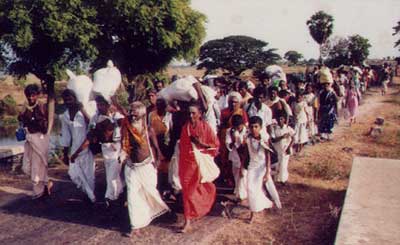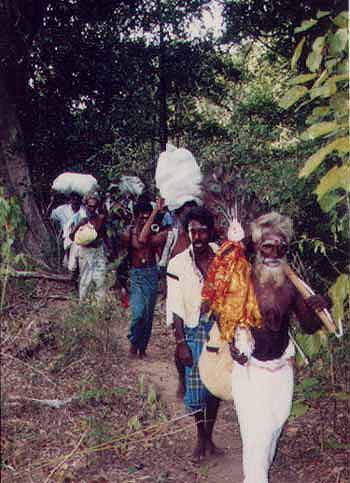|
| ||||
 Pada Yatra pilgrims approaching KataragamaCeylon Daily News (Colombo) article of 12 July 2001
(Kataragama Group correspondent)Hundreds of ardent devotees who walk annually from as far as Trincomalee to Kataragama for the Esala festival are now crossing Yala National Park and are expected to reach the famous shrine on 21 July in time for the flag-hoisting ceremony. Officials, who are noting a dramatic upsurge in the number of pada yatra groups this year, expect the number of foot pilgrims to surpass the ten thousand mark reached only in recent years. Pilgrims who undertake vows to walk to Kataragama from Trincomalee must start forty days before the festival begins. While most are Tamil Hindus, many Tamil-speaking East Coast Veddas also join as well. From Akkaraipattu their ranks swell to include Sinhala Buddhists, Muslims and Christians as well as devotees from Europe, America and Australia. Sleeping under the stars at night and depending upon the generosity of local villagers for their sustenance, the pilgrims learn to trust in the Kataragama God's mysterious ways. All along the route from Trincomalee the pilgrims receive dana or food offerings both from Tamil and Sinhala villagers and also occasionally from the security forces as well.
One lead party alone included over 200 mostly elderly men, women and children upon arrival to Pottuvil, Panama and Okanda where hundreds more are arriving by bus to share in the experience of walking nearly 100 kilometres across Deviyange Kaele ('God's own Forest'). Only days ago Okanda Malai Vel Ayudha Swami Kovil celebrated its Maha Kumbhabhisekam (consecration), and this has further swollen the ranks of devotees coming to Okanda en route to Kataragama. Until the last century, the trek to Kataragama was considered to be so dangerous that few villagers would undertake it without first receiving a 'call' from Kataragama. Even today the trek involves some hazards as well as hardships. As in past years, Sri Lankan security forces have been extending their support also to the foot pilgrims, especially in Yala National Park where medical supplies and provisions are scarce. Army units stationed in Yala are now preparing to extend a warm welcome to arriving pilgrims. The pilgrims typically undertake simple vows of self-denial during the Kataragama season in return for the God's assistance in solving their personal problems. The commonly go barefoot the entire distance under scorching sun and along battered roads in remote districts. According to a spokesman for the Kataragama Devotees Trust, for centuries the Kataragama Pada Yatra has been a great unifying factor in Sri Lankan society. Until the 1980's pilgrims used to walk from Jaffna district and even from India. This year a few intrepid swamis walked from Vattappalai Kannaki Amman Kovil near Mullaitivu. After the communal riots of July 1983, the tradition fell into abeyance and nearly died out until the Kataragama Devotees Trust revived it in 1988. Now once again the pilgrims' spirited shouts of 'Haro Hara' (hallelujah) may be heard up and down the entire East Coast once more during the Kataragama season. See also these reports: Pada Yatra 1988 | Pada Yatra 1997 | Pada Yatra 1999 | Pada Yatra 2000 | Pada Yatra 2002 |

